
This is a textbook for an introductory course on Cultural Anthropology.
- Subject:
- Anthropology
- Social Science
- Material Type:
- Textbook
- Provider:
- LibreTexts
- Date Added:
- 05/02/2023

This is a textbook for an introductory course on Cultural Anthropology.

An introductory cultural anthropology textbook covering all major topics and produced by Lumen Learning.

This is a short, in-class activity. Students will complete a brief individual carbon-footprint and will then be given a card with information about the carbon footprint of an individual in another part of the world. Students will then be asked to reflect on the 'climate consequences' faced by that person compared to the 'climate consequences' they themselves face. Discussion will lead into consideration of current and future effects of climate change on cultures in our own bioregion - as well as a reflection on the way our own cultural practices may be contributing to the climate catastrophe worldwide.
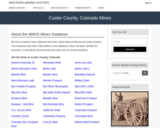
This Western Mining History database uses Mineral Resources Data System to list known Colorado historical mines by county. Each county site has links to the known mines within its borders. Some are known and named, others are unnamed. Mines should be assumed to be on private property unless other research is conducted. Data provided for each mine site include: Name, State, County, Elevation, Primary Mineral Mined, Latitude and Longitude and a link to Google Maps. Photos are provided where available. Additional information for some Mines are satellite photos, and ownership, business and historical records. Mining History is an historical site that provides information on mining, mining towns, the gold and silver rush, and Photos and maps of the western United States. This is a great database for student historical research or data and statistics classes. Consider becoming a member or making a donation to help further the work of the site.
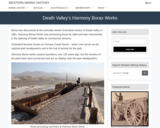
Western Mining History presents a short history of the California Gold Rush. Western Mining History is an historical site that provides databases, information on mining, mining towns, gold and Photos and maps of the western United States. Consider becoming a member or making a donation to help further the work of the site.

This assignment addresses cultural sustainability by asking students to go beyond distinguishing between five subsistence strategies to examining the impact of globalization on diet and culture.
(Note: this resource was added to OER Commons as part of a batch upload of over 2,200 records. If you notice an issue with the quality of the metadata, please let us know by using the 'report' button and we will flag it for consideration.)
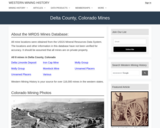
This Western Mining History database uses Mineral Resources Data System to list known Colorado historical mines by county. Each county site has links to the known mines within its borders. Some are known and named, others are unnamed. Mines should be assumed to be on private property unless other research is conducted. Data provided for each mine site include: Name, State, County, Elevation, Primary Mineral Mined, Latitude and Longitude and a link to Google Maps. Photos are provided where available. Additional information for some Mines are satellite photos, and ownership, business and historical records. Mining History is an historical site that provides information on mining, mining towns, the gold and silver rush, and Photos and maps of the western United States. This is a great database for student historical research or data and statistics classes. Consider becoming a member or making a donation to help further the work of the site.
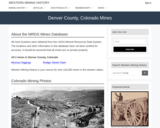
This Western Mining History database uses Mineral Resources Data System to list known Colorado historical mines by county. Each county site has links to the known mines within its borders. Some are known and named, others are unnamed. Mines should be assumed to be on private property unless other research is conducted. Data provided for each mine site include: Name, State, County, Elevation, Primary Mineral Mined, Latitude and Longitude and a link to Google Maps. Photos are provided where available. Additional information for some Mines are satellite photos, and ownership, business and historical records. Mining History is an historical site that provides information on mining, mining towns, the gold and silver rush, and Photos and maps of the western United States. This is a great database for student historical research or data and statistics classes. Consider becoming a member or making a donation to help further the work of the site.

An ethnography expedition enables you to gain understanding, discover insights, and (re)frame design opportunities.

Elementary students design their own pottery based on a Native American design seen at the Museum of the West

The overarching goal of this exercise is for students to explore the early anthropogenic hypothesis, which claims that early agriculture had a substantial impact on greenhouse gases and global climate thousands of years ago (Ruddiman, 2003). Students compare changes in greenhouse gas concentrations that occurred thousands of years ago to more recent changes that occurred over hundreds of years. Students also relate changes in greenhouse gas concentrations to warming. The exercise is completed over a 1.5- to 2-week period as the class covers a chapter on climate change.
(Note: this resource was added to OER Commons as part of a batch upload of over 2,200 records. If you notice an issue with the quality of the metadata, please let us know by using the 'report' button and we will flag it for consideration.)

Clues from the Landscape Social Studies Lesson 2 Discovering Public Lands as Living Museums is designed to be used with Clues from the Landscape Artifact Kit. Lessons 1, 2 and 4 can be completed without the artifacts from the kit. These kits are available through Musuems of Western Colorado to D51 Teachers. This lesson can be adapted to use without the kit. Students will be able to: • Conduct analysis of different types of maps • Discuss the difficulties faced by homesteaders moving across the state • Describe how homesteaders modified the land around them • Explain why it is important to preserve historic sites • Find information from primary sources including documents, and newspaper articles about life as a homesteader
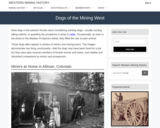
Western Mining History presents a short history of how dogs provided companionship and security for miners in the westen United States. The resources shows Historical|Photographs of arrastras. Western Mining History is an historical site that provides databases, information on mining, mining towns, gold and Photos and maps of the western United States. Consider becoming a member or making a donation to help further the work of the site.

This Western Mining History database uses Mineral Resources Data System to list known Colorado historical mines by county. Each county site has links to the known mines within its borders. Some are known and named, others are unnamed. Mines should be assumed to be on private property unless other research is conducted. Data provided for each mine site include: Name, State, County, Elevation, Primary Mineral Mined, Latitude and Longitude and a link to Google Maps. Photos are provided where available. Additional information for some Mines are satellite photos, and ownership, business and historical records. Mining History is an historical site that provides information on mining, mining towns, the gold and silver rush, and Photos and maps of the western United States. This is a great database for student historical research or data and statistics classes. Consider becoming a member or making a donation to help further the work of the site.
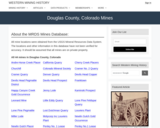
This Western Mining History database uses Mineral Resources Data System to list known Colorado historical mines by county. Each county site has links to the known mines within its borders. Some are known and named, others are unnamed. Mines should be assumed to be on private property unless other research is conducted. Data provided for each mine site include: Name, State, County, Elevation, Primary Mineral Mined, Latitude and Longitude and a link to Google Maps. Photos are provided where available. Additional information for some Mines are satellite photos, and ownership, business and historical records. Mining History is an historical site that provides information on mining, mining towns, the gold and silver rush, and Photos and maps of the western United States. This is a great database for student historical research or data and statistics classes. Consider becoming a member or making a donation to help further the work of the site.

Douglas County Colorado presents a virtual museum showcasing the history of the Douglas, County Colorado Region including Castle Rock, Aurora, and Highlands Ranch.
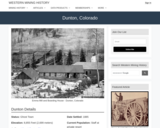
Dunton, CO Mining Town. Western Mining History presents a brief summary of Colorado's Historical Mining Towns with links to additional Colorado resources for a mining town database and mines by county. Western Mining History is an historical site that provides information on mining, mining towns, the gold and silver rush, and Photos and maps of the western United States. This is a strong primary source resource that can be used for a variety of class research projects. Consider becoming a member or making a donation to help further the work of the site.
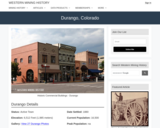
Durango, CO Mining Town. Western Mining History presents a brief summary of Colorado's Historical Mining Towns with links to additional Colorado resources for a mining town database and mines by county. Western Mining History is an historical site that provides information on mining, mining towns, the gold and silver rush, and Photos and maps of the western United States. This is a strong primary source resource that can be used for a variety of class research projects. Consider becoming a member or making a donation to help further the work of the site.
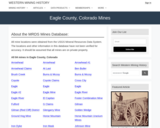
This Western Mining History database uses Mineral Resources Data System to list known Colorado historical mines by county. Each county site has links to the known mines within its borders. Some are known and named, others are unnamed. Mines should be assumed to be on private property unless other research is conducted. Data provided for each mine site include: Name, State, County, Elevation, Primary Mineral Mined, Latitude and Longitude and a link to Google Maps. Photos are provided where available. Additional information for some Mines are satellite photos, and ownership, business and historical records. Mining History is an historical site that provides information on mining, mining towns, the gold and silver rush, and Photos and maps of the western United States. This is a great database for student historical research or data and statistics classes. Consider becoming a member or making a donation to help further the work of the site.

In this video segment from Religion & Ethics Newsweekly, learn how Muslims in America celebrate Eid al-Fitr, the Ű_í_Ű__Ű_Ű_Ű_Feast of Breaking the Fast.Ű_í_Ű__Ű_Ű_Ű_í_Ű_